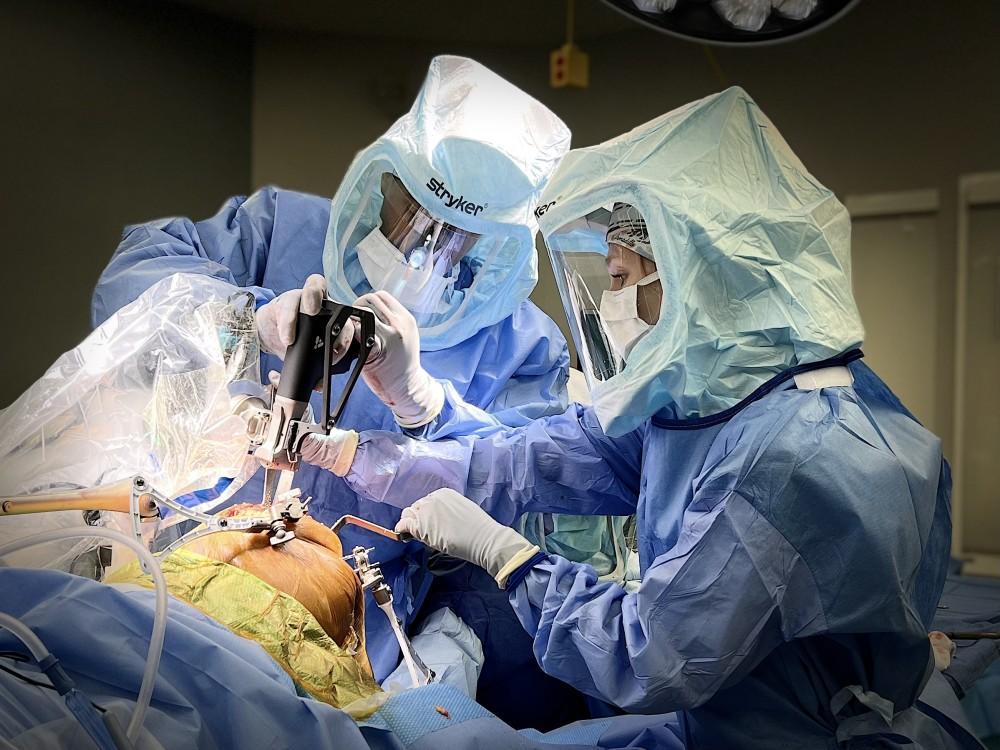
What Is Robotic-assisted Joint Replacement Surgery?

Why was Robotic-assisted surgery developed?
Joint replacement surgery involves removing the diseased cartilage and bone in the hip or knee and replacing these areas with prosthetic parts. Hip replacement surgery, as well as both total and partial knee replacement surgery, historically has excellent outcomes when used to treat patients with degenerative joint disease. However, as with any surgical procedure, there are risks that are involved with joint replacement surgery. In particular, certain complications are closely tied to surgical technique and accurate placement of the implants. Therefore, newer technologies such as robotic-assisted surgery, have been developed to improve the overall accuracy of component positioning in hip and knee surgery.
How does it work?
In general, the software relies on an accurate preoperative map of the patient’s anatomy, typically generated from a CT scan, although some newer systems may be able to do so in the future without the need for pre-operative CT. During surgery, the program interprets the information obtained from the preoperative map and correlates this to the patient’s actual anatomy which is mapped by the surgeon during the operation. Once the software has accurately mapped the patient’s actual anatomy to the pre-operative plan, the surgeon is able to precisely plan the bone cuts and implant position for that particular patient. Therefore, the primary advantage of this robotic-assisted technology is the improved precision in placing the implants where the surgeon feels that the implant should best be positioned.
Is robotic-assisted surgery better than conventional joint replacement surgery?
Research has shown that robotic-assisted surgery is more accurate at implant positioning than conventional joint replacement techniques. However, despite these advantages, it is unclear whether patients do better functionally in the short term and whether implant longevity is enhanced in the long term with robotic techniques. For more sensitive procedures such as partial knee replacement surgery, the improved accuracy from the robot and the ability to balance the soft tissue tension of the knee can be very useful to the surgeon. Similarly, in patients with complex hip socket anatomy such as in hip dysplasia or others afflicted with post-traumatic knee arthritis with tibial and femoral hardware in place, robotic-assisted surgery may be of benefit.
Final thoughts
Robotic-assisted surgery is an excellent surgical choice for patients with severe hip or knee arthritis and when the surgeon feels the assistance of the robotic technology is warranted. The procedure continues to improve how we take care of patients and patients are having excellent outcomes as a result. Don’t hesitate to contact us for more information.
Dr. Ugo Ihekweazu, is an orthopedic surgeon and an expert in Hip and Knee Replacement surgery in the Greater Houston Area. Dr. Ihekweazu is a member of the Fondren Orthopedic Group with offices in the Texas Medical Center and Willowbrook/Cypress. Dr. Ihekweazu has particular expertise in minimally invasive anterior and posterior total hip replacement surgery, hip resurfacing, partial knee replacement, minimally invasive total knee replacement surgery, computer navigation, robotic-assisted surgery, complex joint replacement and revision joint replacement surgery. If you have further questions about any of these surgical options please contact us today to make an appointment.
You Might Also Enjoy...


Robotic-Assisted Knee Replacement Surgery

100 Velys Robotic-Assisted Knee Replacement Surgeries

Texas Orthopedic Association Annual Meeting

DePuy Velys Robotic Assisted Knee Replacement Surgery



